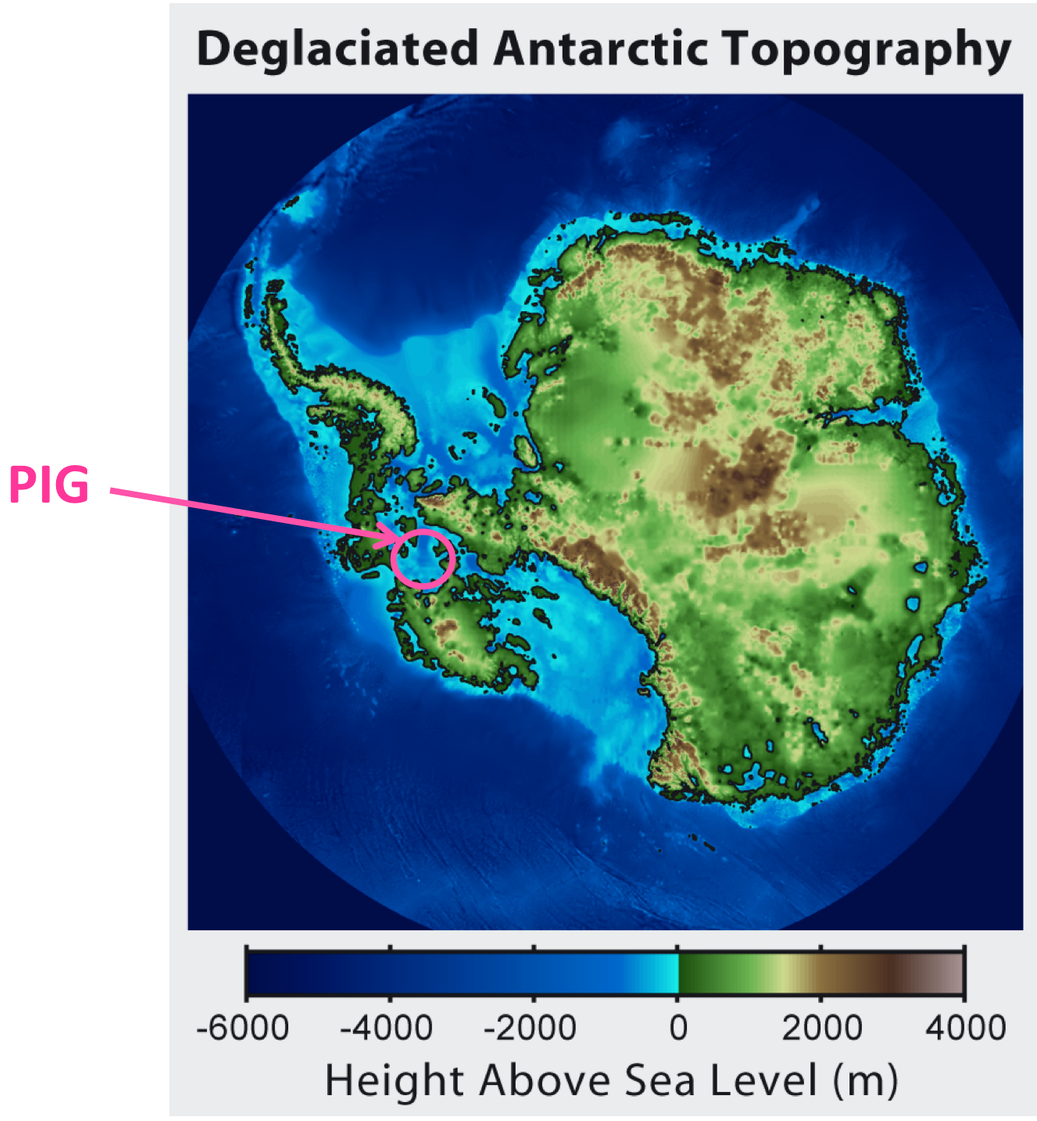the story of PIG and US by veselina yakimova
Logo courtesy of NASA, by Sarah Arsenoff
This is PIG. PIG lives in Antarctica and he is happy with it. He truly enjoys the cool temperatures down there. But since global warming became an issue he started getting worried about his future.
In fact, he is so worried that he is sweating. And he is also losing a lot of weight, which is not good for a PIG. So doctors came to check him up. After extensive temperature measurements and radar examinations, it turned out that PIG is being slowly eaten by a nasty sea monster that has been sneaking underneath him.
Watch Video of Veselina giving this presentation.
PIG is actually the Pine Island Glacier Ice Sheet. And the role of the sea monster that attacks it is played by the circumpolar deep water currents. These deep warm waters sneak underneath the ice shelf and melt out huge portions of the ice. What makes PIG so susceptible to these ocean currents is mainly its location as part of the West Antarctic marine ice sheet.
Photo credit: NASA/Michael Studinger
The Trans Antarctic Mountains geographically divide the large ice sheet covering Antarctica into two distinct parts. The larger East Antarctic sheet lies on continental crust which is mainly above sea level. With only 10% of the total Antarctic ice volume, the far smaller West Antarctic Ice Sheet lies mostly on the ocean floor, and in some places as much as two thousand meters below sea level. This is what Antarctica would look like if we melted all of the ice. As you see where PIG originally sits, would be mainly open water.
Image created by Robert A. Rohde / Global Warming Art
PIG sits on the ocean floor, making it much more accessible for the sea monster to get to it. The sea monster eats away its base and the grounding line is forced to retreat. The grounding line is the boundary between the floating ice shelf and the resting on bedrock ice that feeds it. But this retreat of the grounding line is also making our PIG unstable. Marine ice sheets have a dynamic instability when there is over deepened bedrock behind the grounding line. Ice discharge increases with ice thickness - to the fifth power! For a bed sloping down towards the interior the ice gets thicker in the same direction, therefore discharge increases as the grounding line retreats. This leads to ice sheet thinning which causes grounding line retreat into even deeper water where ice is even thicker. Thicker ice results in increased discharge, which further thins the ice, which results in further retreat into deeper water and so on. This positive feedback will continue until an upward sloping bed is reached. There grounded ice will start thinning and will eventually attain balance. Until then then there is nothing to be done that can stop the ice sheet retreating. And all it took to trigger this instability was the sea monster eating out the underside of the PIG ice shelf… this sea monster being the deep, warm water currents.
Image from AntarcticGlaciers.org based on Schoof, 2010.
But are these currents really the bad guys?? It turns out that they have someone much bigger and stronger behind their backs – the increasing Westerly winds.
Image courtesy of NASA/NSIDC
The Westerlies are the prevailing winds that blow from the high pressure area in the horse latitudes towards the poles. The process of the Westerlies intensification is caused by heat imbalance. This heat imbalance is caused by the combination of stratospheric cooling due to ozone depletion and atmospheric warming due to greenhouse gases. While the Westerlies circle around the Antarctic continent with their persistence they manage to increase the surface ocean currents. So the winds’ increase in strength will also disturb the surface water flow manners. And their direct interaction with the warmer deep currents will drag these deep currents underneath the unfortunate PIG ice shelf.
And Pine Island is not the only place in the world where this is happening. Similar threat due to ice sheet instability hides underneath all parts of the West Antarctic ice sheet that are below sea level. And in addition, the marine based outlet glaciers of Western Greenland (show on map). Such rapid change in the ice sheets is likely to rise sea level with 1m by 2100. 145 million people will be displaced and the lives of 2 billion people living in coastal areas around the globe will be affected.
This trend does not sound like a very happy ending. However, the good thing is that we are not there yet. As I already told you the intensification of the Westerlies is caused by ozone depletion and greenhouse gases. So after all it is US that hold the trigger in this whole horror story. And that also means we have the power to stop it. The ozone hole is already healing slowly because of improvements the whole world incorporated. I believe that people are also able to take control over greenhouse gases. Ultimately it is us that get to write the screenplay for the future of the PIG and the sea monster.
Image courtesy of NASA
For more information, here are some links:
Bethan Davies nice writeup with neat imagery and animations.






